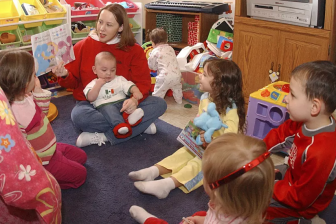Growing up in a rough neighbourhood can shape kids’ brains, so good parenting and schooling is crucial
Growing up in a poor or disadvantaged neighbourhood can affect the way adolescents’ brains function, according to our new research. It can alter the communication between brain regions involved in planning, goal-setting and self-reflection.
These brain changes can have consequences for cognitive function and well-being. But the good news is that we also found positive home and school environments can mitigate some of these negative effects.
A “disadvantaged neighbourhood” is one in which people generally have lower levels of income, employment, and education. Growing up in these conditions can cause stress for children, and is associated with cognitive problems and mental health issues in young people, write Divyangana Rakesh, The University of Melbourne and Sarah Whittle, The University of Melbourne.
We don’t yet know exactly how this link between neighbourhood disadvantage and poor mental outcomes works, but it is thought that social disadvantage alters the way young people’s brains develop.
The brain during childhood and adolescence
During childhood and adolescence, our brains are dynamically developing. During this phase of life, we refer to the brain as being particularly “plastic”, meaning it is susceptible to change as a result of experiences.
Exposure to negative or stressful experiences (such as neighbourhood disadvantage) may alter brain development in a way that makes some adolescents less resilient in the future. In particular, exposure to neighbourhood disadvantage may lead to “developmental miswiring” – alterations in communication between different brain regions. Such miswiring is increasingly recognised as playing an important role in mental illness.
Neighbourhood disadvantage and the brain
In our research, we studied more than 7,500 children aged 9-10 years from the Adolescent Brain Cognitive Development (ABCD) Study, a large long-term study of brain development and child health in the United States. This study features children from schools all over the country, with lots of diversity in race, ethnicity, education, income levels, and living environments.
Using these data, we tested whether neighbourhood disadvantage is associated with changes in the brain’s “resting functional connectivity” in magnetic resonance imaging (MRI) scans.
Resting functional connectivity refers to the coordinated activity of different brain regions when someone is resting and thinking of nothing in particular. Even while resting, we typically see synchronised activity between brain regions that usually work together to perform tasks. That is, these brain regions are “functionally connected”.
We found that children who grew up in disadvantaged neighbourhoods had widespread alterations in functional connectivity, in brain regions considered important for learning and memory, planning, goal-setting, self-reflection, sensory processing and language. We quantified neighbourhood disadvantage using an “area deprivation index” — a composite measure of factors including income, employment and education for individuals in a given neighbourhood.
What’s more, 50% of these brain changes were associated with poor cognition and mental health in the children. This suggests that growing up in a tough neighbourhood led to changes in children’s cognitive function and mental health.
It is important to note that because the study was “cross-sectional” (that is, it included only one time point), these inferences about causation are speculative. What’s more, we don’t know what mechanism causes these changes in brain connectivity, and why some brain regions are affected but not others.
Reducing the effects of neighbourhood disadvantage
As part of the ABCD Study, children and parents also completed questionnaires about their living environment. This allowed us to look at whether positive home and school environments can offset some of the negative effects of neighbourhood disadvantage.
Crucially, we found that brain alterations were less pronounced in children who had positive home and school environments. This suggests that good parental support and positive schooling can buffer some of the negative effects of growing up in a disadvantaged neighbourhood.
Parental support comprised of things such as the parent smiling often at the child, supporting the child and making them feel better when they’re upset, discussing the child’s worries with them, and expressing their love for the child.
Positive school environments were characterised by the availability of extracurricular activities, healthy relationships between children and teachers, children feeling safe at school, teachers praising children when they did a good job, schools letting parents know when children did something well, and children having opportunities to contribute to decisions about activities and rules.
Teachers praising children when they did a good job
The impact of the social environment on brain development during the early years is already widely recognised in early childhood learning. But the impact that parents and teachers might have on the brains of older children and adolescents has been less clear.
Our research shows that parents and teachers continue to be an important source of support for children as they move into adolescence. Although peers start to become important during this transition, parents and teachers play a role in promoting healthy brain development.
While disadvantaged neighbourhoods can negatively affect children’s brain development and well-being, this can be offset by giving children better home and school environments where they feel supported, receive positive feedback, and have opportunities to engage in different activities.![]()
Divyangana Rakesh, PhD Candidate, The University of Melbourne and Sarah Whittle, Associate Professor in Psychiatry, The University of Melbourne
This article is republished from The Conversation under a Creative Commons license. Read the original article.





